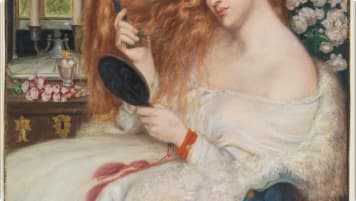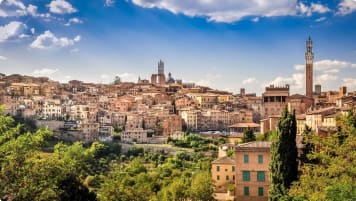Piecing Together the Life of Caravaggio
Uncovering Caravaggio The following article picks up on, and extends, our general introduction to Caravaggio. Here, we we delve further into the details of Caravaggio’s early life and relationships and use available evidence to piece…
11 Oct 19 · 19 mins read
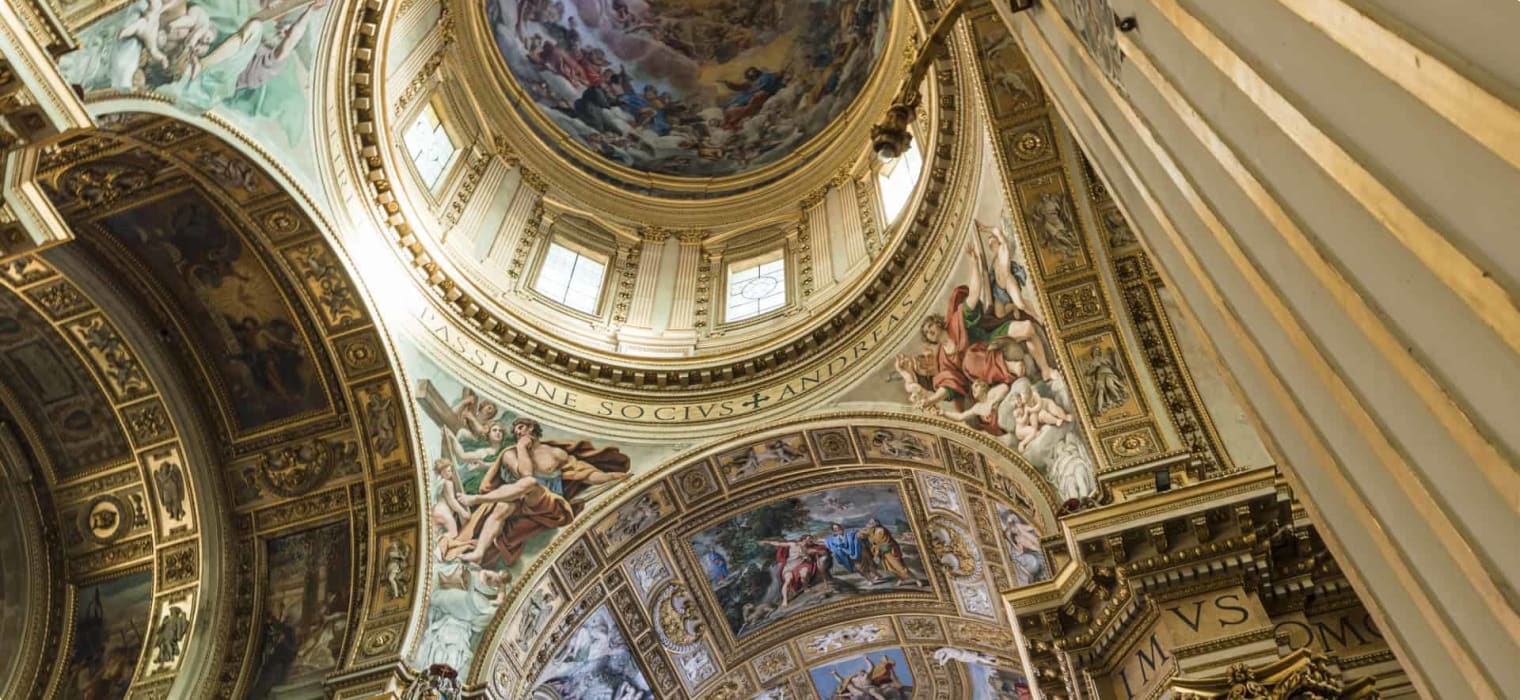
Uncovering Caravaggio
The following article picks up on, and extends, our general introduction to Caravaggio. Here, we we delve further into the details of Caravaggio’s early life and relationships and use available evidence to piece together his career and events leading to his untimely death. Odyssey Traveller offers a tour based on the life and work of Caravaggio. It visits Italy, Malta and Sicily in order to follow in the artist’s footsteps, and develop an understanding of this time in history. If you wish to research further, we have recommended a reading list of ten books on Caravaggio. And if you are interested in accompanying us on the Caravaggio tour, please don’t hesitate to get in touch. We have several departures scheduled for 2020 and 2021.
Early Life
Michelangelo Merisi, known to us as Caravaggio, was probably born on the 29th of September, 1571 – the feast day of his namesake, Saint Michael. There is some debate as to whether he was born in Milan or the nearby town of Caravaggio (which would become his namesake) where his father’s employer, Francesco Sforza, was the Marquis.
Francesco Sforza had attended the wedding of Caravaggio’s parents, Fermo Merisi and Lucia Aratori. Lucia was from a well-known local family and it was possibly this, as much as the fact that Fermo worked for the Marquis, which took Francesco to the wedding. For whatever reason, the Sforza-Colonna family was to play a very important role in Caravaggio’s future.
Caravaggio probably spent the first few years of his life mainly in Milan. However, the outbreak of plague in 1576 caused the family to move out to the fortified hillside town of Caravaggio, where Fermo Merisi owned property and where they could expect to enjoy the protection of the Marquis. Unfortunately the move was too late for Fermo. In a very short space of time Caravaggio was to lose his father, uncle, grandmother and grandfather to the plague, all before he was six. This tragedy would leave an indelible mark on Caravaggio and many believe it could be one of the explanations for his life of violence.
Caravaggio, his mother, brother and sister went to live with his maternal grandparents on property they owned in Caravaggio. Here he remained until 1584, when, aged 13, he moved to Milan and entered into an apprenticeship with the painter, Simone Peterzano. Peterzano, according to the contract details, had been a student of Titian but very little is known about the four years Caravaggio spent under his tutelage. There are no known works existing from this period. In fact, there are no authenticated works known up until the time Caravaggio reached Rome at the age of 21.
Travelling Italy
Caravaggio’s mother is thought to have died in 1590 when he was 19. At this point he sold the land that had been his inheritance and lived on the money. Not much is known about this period in his life. It is possible that he travelled in Northern Italy and absorbed some of the painting techniques of the local artists both past and present. It is even possible that he travelled as far as Venice where he would have seen, and perhaps been influenced by, works of Titian, Tintoretto and Jacopo Bassano.
In 1592 Caravaggio, having spent his inheritance, set out for Rome. One of Caravaggio’s early biographers, Giovanni Baglione, a rival and bitter enemy, claimed that Caravaggio had committed murder in Milan and it was this that caused him to flee the city. Despite a great deal of recent research no evidence for this murder has emerged.
Caravaggio made little initial impression on the Roman art scene. Rome was full of painters and Caravaggio was just one more trying to make a name for himself. In 1593 he took a placement in the studio of Giuseppe Cesari, a member of Rome’s painting academy, where he was set to work as a ‘painter of flowers and fruit’. This, Caravaggio found far from exciting.
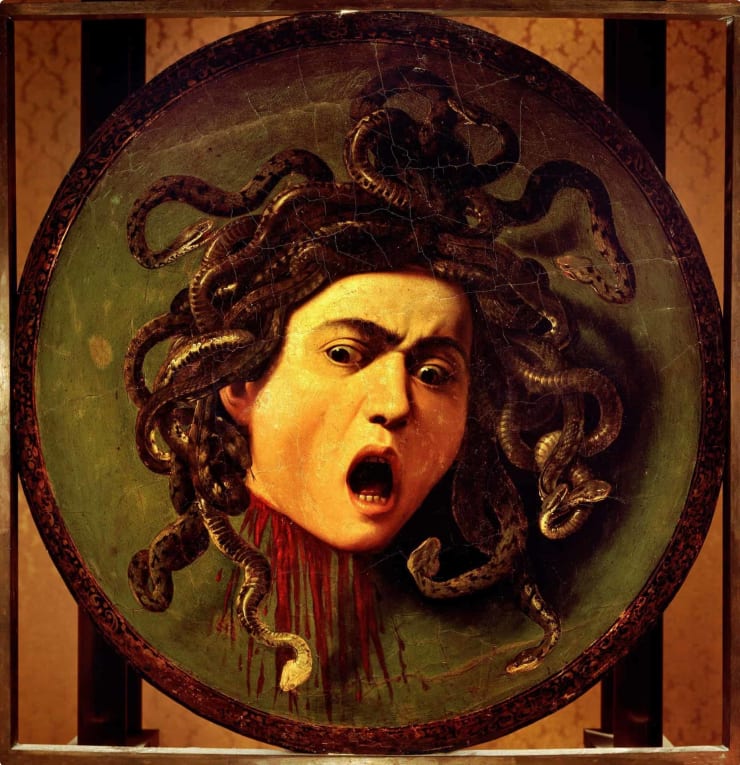
Milan in the time of Caravaggio
By the time Caravaggio was born in 1571, Milan had lost its independence. The Visconti dynasty had been followed by that of the Sforza family but they, although still important landowners, in turn had given way to French rule some 50 years before Caravaggio’s birth. Eventually the Spanish Habsburgs had made Milan part of their vast empire.
When Caravaggio was born, Milan had a population of 100,000 and was full of noise, bustle, trade and industry. It was very different from the small town where he spent most of his childhood. Milan was a city of conspicuous opulence and luxury trades such as silk and sword making. It was also distinguished by its very large number of churches.
Milan was built on a circular plan with the massive Castello Sforzesco at its centre. Built originally for the Sforza dynasty, by the time Caravaggio knew Milan, the Castello was the refuge of the Spanish governors. From the Castello they kept a watchful eye on the city and the surrounding countryside.
The surprising influence of Carlo Borromeo
The dominant figure in Milan in Caravaggio’s time, however, was not a Spaniard but an Italian, Carlo Borromeo, who became Archbishop of Milan in 1565. He was a deeply pious man with a fierce sense of mission. Borromeo was a charismatic leader who had renounced wealth and privilege to follow in Christ’s footsteps.
Under his steely control the citizens of Milan were to be indoctrinated in the ways of his own brand of piety, whether they liked it or not. He had a bleak view of human nature, believing that man was tainted by original sin. He believed it was his duty to transform the life and habits of the men and women of Milan. For two decades, throughout the formative period of Caravaggio’s life, the archbishop pushed through “reforms” intended to control the hearts, minds and souls of the people. He saw sinfulness everywhere and his priests were seen by him as the army leading the fight against man’s sinful nature.
Borromeo tried to ban dancing on feast days and Sundays. He attempted to kill off the pre-Lenten tradition of Carnival. He prohibited jousts, tournaments, plays and masquerades. A popular uprising following these prohibitions, however, forced him to admit that there were some limits to his power.
Despite his inflexibility Borromeo was a charismatic leader who changed his world. There is good reason to believe that his ideas would have had a profound influence on Caravaggio and his art. Borromeo seems to have preferred the more traditional, popular representations aimed squarely at the promotion of mass piety. Caravaggio’s mature paintings such as The Crucifixion of St Peter and The Conversion of St Paul are rooted in the tradition of popular pious realism so espoused by Borromeo.
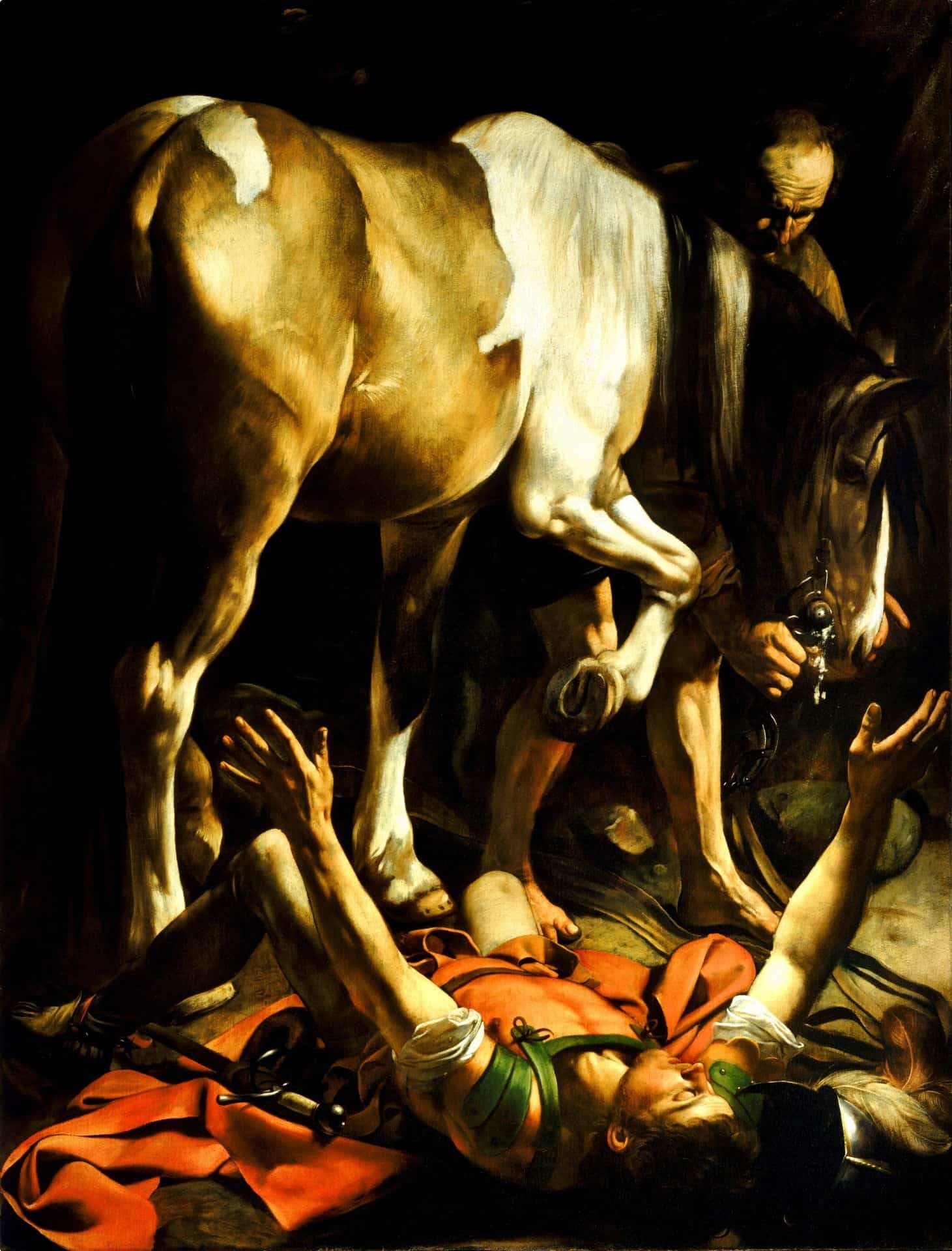
The religious art that Caravaggio was destined to create was closely aligned to the beliefs of Borromeo despite the many aspects of Caravaggio’s life and work of which the archbishop would have strongly disapproved.
Caravaggio in Rome
‘Rome was even more violent than Milan, full of plague survivors and refugees from the endless wars among the Italian peninsula’s patchwork of petty states. Soldiers, labourers, priests and painters were all on the lookout for a living and Caravaggio revelled in the squalid, crowded and neglected conditions.’ (This is Caravaggio, Annabel Howard, p9.)
When Caravaggio arrived in Rome, the city was in the midst of a great program of rebuilding. The sack of the city by the forces of Charles V in 1527 had left it in ruins and restoration was a long time coming. Then, in 1585, a new pope, Sixtus V, was elected and he set out to rebuild Rome, spiritually and physically. Under Sixtus V and the popes who immediately followed, Rome was dramatically altered. New roads were built, the Dome of St Peter’s was completed and ancient Christian monuments were restored.
Caravaggio arrived in Rome shortly after the election of a new pope, Clement VIII. Clement was determined to carry on the work of his predecessors. He wanted to reassert Rome as the centre of Christendom and believed that the beauty of Rome’s churches would help to bring this about. Consequently, Rome began to fill with artists of all kinds as painters, sculptors and architects all flooded into the city. Rome became the artistic capital of Europe.
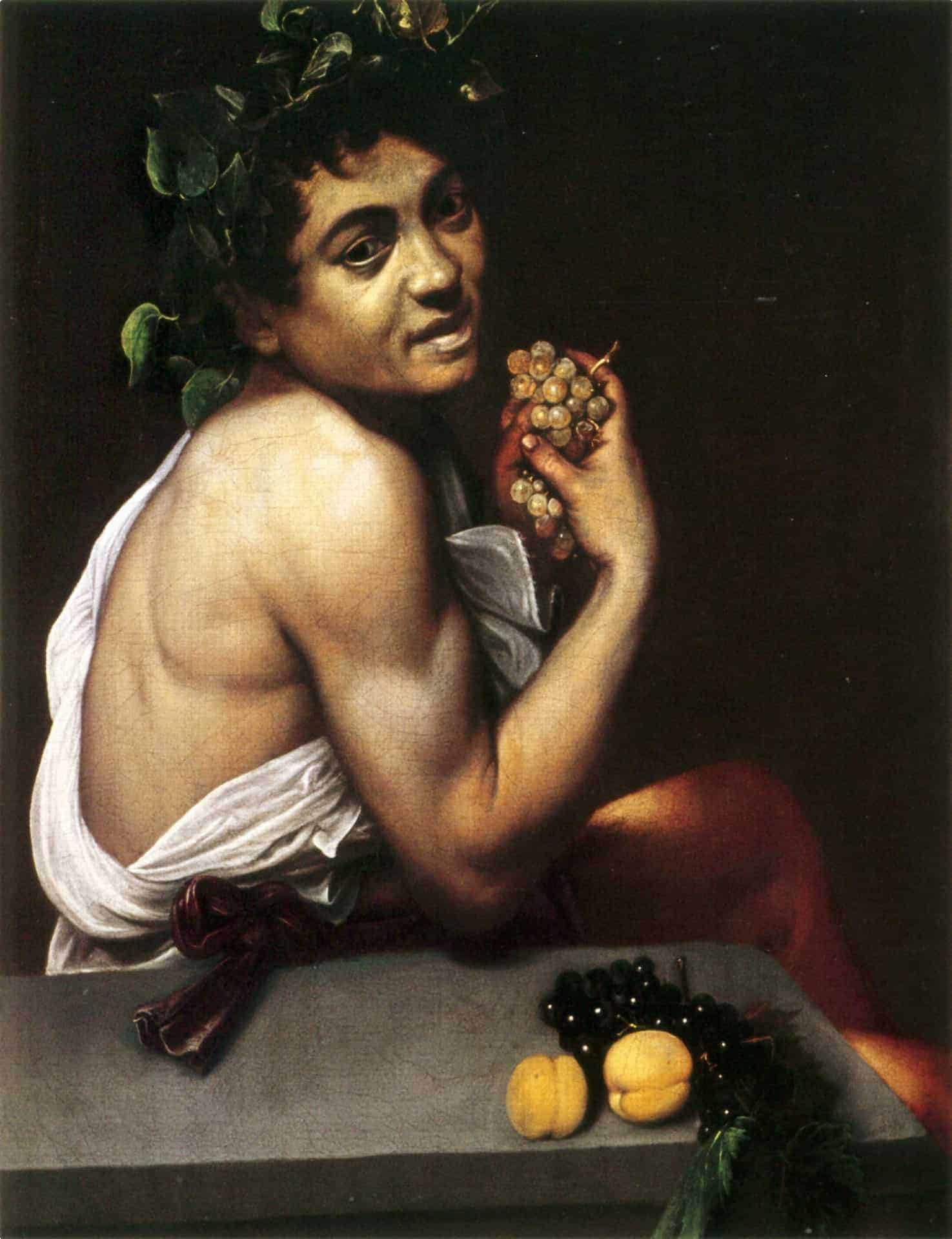
At first Caravaggio made little impression in the overcrowded art world that was Rome. Although he found a position in the studio of Giuseppe Cesari in 1593, he found the work and life far from congenial. Bored with the endless flowers and fruit that were his lot, Caravaggio began to experiment with a self-portrait depicting himself as Bacchus. Caravaggio’s realism was considered shocking by many establishment painters in Rome, but it was beginning to create interest among influential patrons of art.
Cardinal Francesco Maria Del Monte
In 1595 Caravaggio came to the attention of Cardinal Francesco Maria Del Monte who bought one of his paintings, The Cardsharps. Del Monte lived in the Palazzo Madama, owned by the Florentine Medici family, for whom he acted as a political agent and artistic advisor.
Del Monte was described by his contemporaries as a philanthropist, patron and a generous, intelligent man. He was a busy and successful diplomat with an interest in art. His collections were varied and included sculptures, ceramics, antiquities and books as well as paintings. His interest in Caravaggio and his work made a huge difference to the young painter’s life.
Not only did Del Monte buy Caravaggio’s paintings, he offered him a home in the Palazzo Madama. Caravaggio now had stability, wealthy patrons and an influential protector. And, a protector was something he needed increasingly as the years went on and his character remained tempestuous and his actions unrestrained.
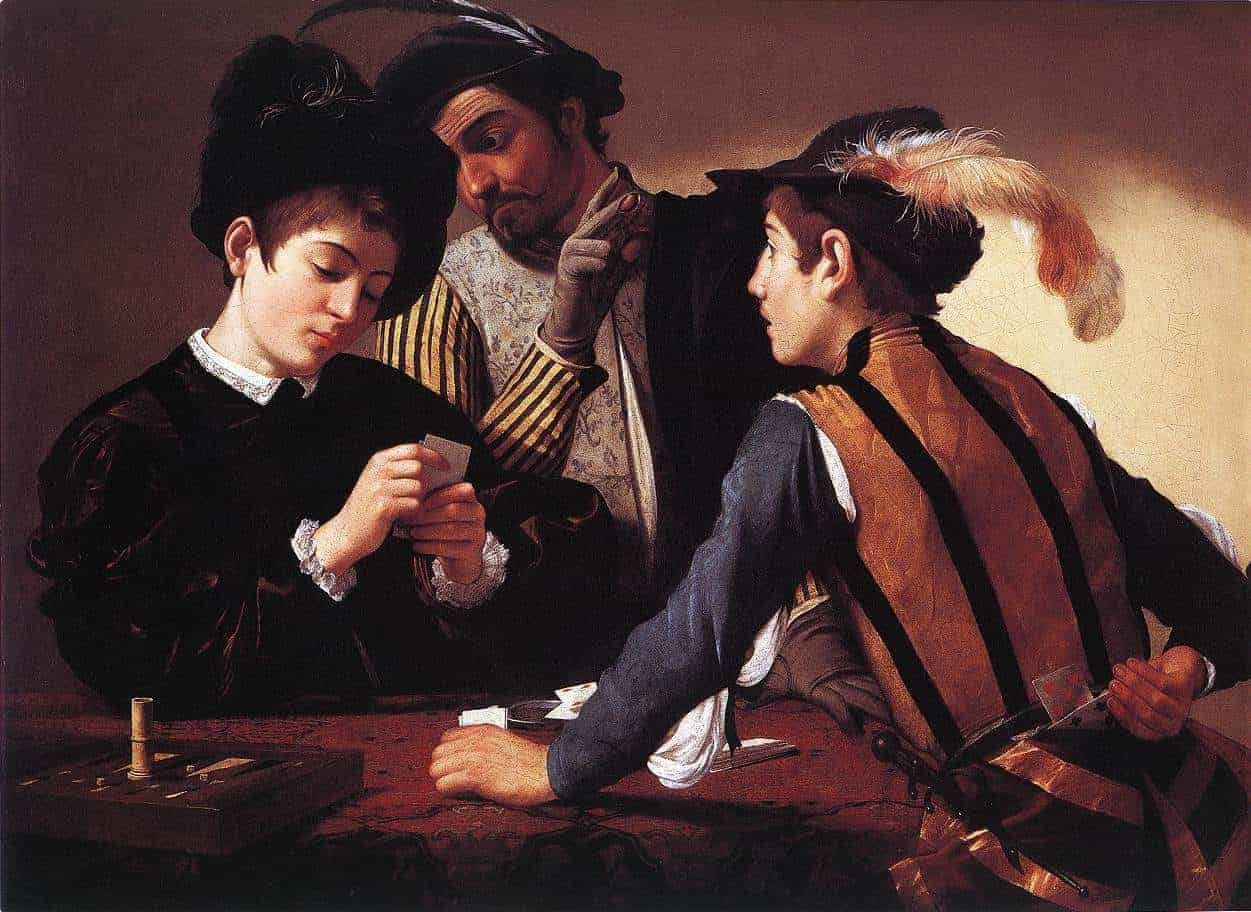
The Palazzo Madama (now the seat of the Senate of the Italian Republic but once home to Cardinal Del Monte and Caravaggio).
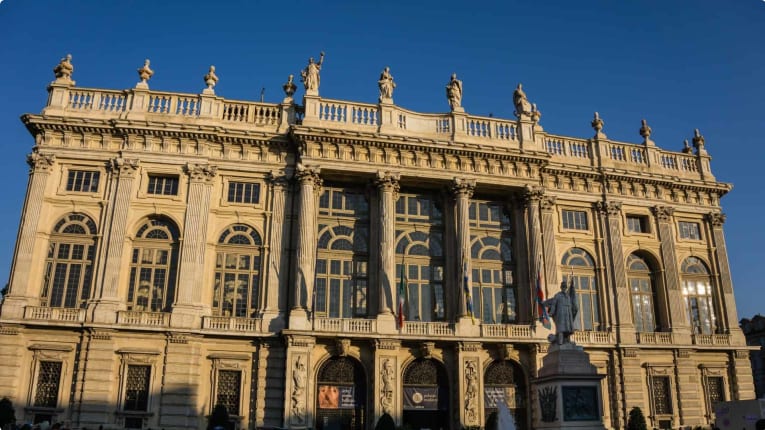
Over the next few years Caravaggio continued to live in the Palazzo Madama under the protection of Del Monte. His paintings were bought by Del Monte and other members of his circle. Vincenzo Giustiniani, a wealthy friend and neighbour of Del Monte, went on to buy a total of 13 works from the artist. It was, however, some time before Caravaggio managed to break into the church scene where reputations could really be made. By 1599 Caravaggio had still not been offered even one public commission. This situation was about to change.
A new sensation
Caravaggio was put forward by Del Monte to paint two canvasses for the Contarelli Chapel in the church of San Luigi dei Francesi, just around the corner from the Palazzo Madama. The priests in charge of the chapel were desperate for the decorations to be completed before Jubilee celebrations of 1600 and decided to give Caravaggio the chance.
The two paintings, The Calling of St Matthew and The Martyrdom of St Matthew were completed in 1600 and caused a sensation. People flocked to the chapel to view the paintings. Not everyone was delighted and notable criticism came from the president of the Academia di San Luca who declared that the paintings were “too natural” and lacked imagination. Fortunately, not everyone agreed and Caravaggio was given a number of further commissions.
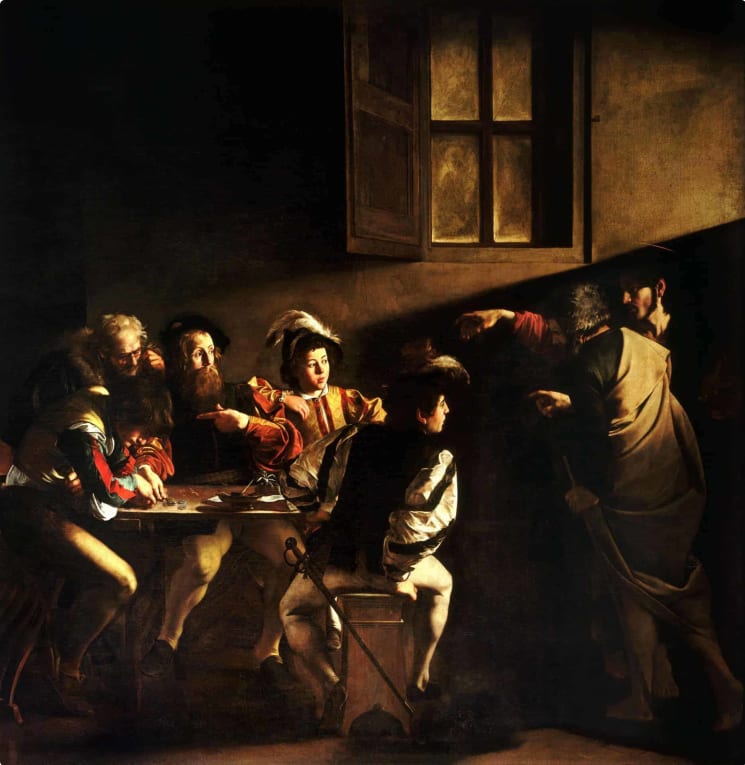
Del Monte now encouraged Caravaggio to move to the nearby Palazzo Mattei, home of ‘the erudite, wealthy and pious Cardinal Girolamo Mattei’ and his two brothers. The Mattei brothers were big art collectors and did a great deal to extend Caravaggio’s reputation. Del Monte, however, remained a good friend to the young painter, helping him to get out of trouble a number of times when Caravaggio had problems with the police.
Conflict with the Law
Despite the fact that he was now settled into comfortable accommodation and making a name for himself as a painter, Caravaggio often found himself in trouble with the law. He was hot tempered and quick to retaliate if he felt himself to be insulted. A number of times he was arrested for carrying a sword through the streets after dark. In 1600 he got into trouble for engaging in a sword fight with a young mercenary whom he wounded. In the same year, he ambushed a painter called Girolamo Spampa, causing considerable damage but not killing him. Caravaggio was fortunate to have influential friends who were able to rescue him from the problems he was causing himself.
Caravaggio had rich and influential patrons but he also had many friends from very different walks of life. Many of the young painters he socialised with were just as hot tempered as he was. In 1603, Caravaggio and two of his friends found themselves in prison for writing insulting and libellous poetry. His trial did not go well but he was suddenly released on bail. It seems that his powerful patrons had come to the rescue once again.
He left town for a while hoping that the trouble would blow over. He spent some time in the town of Loreto where the house of the Virgin Mary had been deposited by angels! Caravaggio was researching his next big altarpiece. On his return, a year later, he painted his revolutionary, barefoot virgin, The Madonna of Loreto. The model for his Madonna was a woman called Lena, one of the local prostitutes with whom he was friendly. In fact, one of his early biographers called Lena, ‘a courtesan whom he loved’. This fact did not go down well with the Church, nor did the fact that the pilgrim’s dirty feet were very much on display.
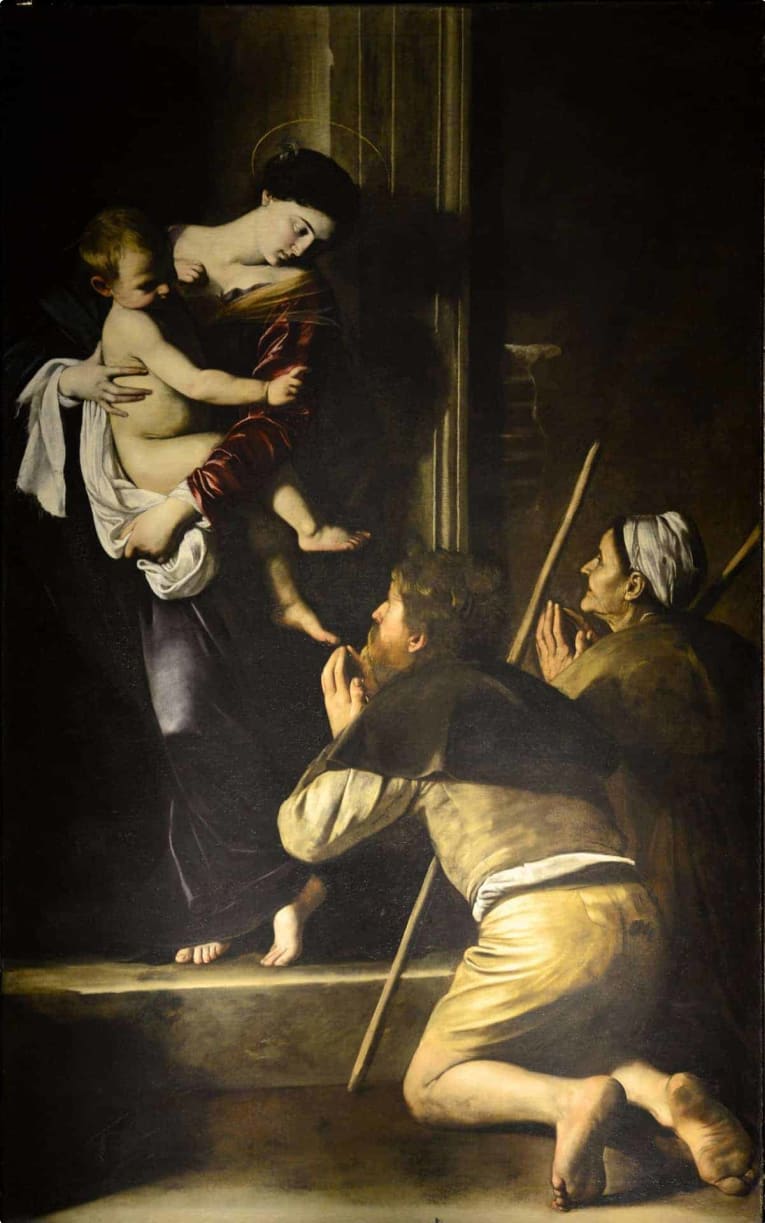
On his return to Rome Caravaggio did not stay out of trouble for long. In April 1604 he was arrested for throwing a plate of artichokes at a waiter. Later that year he was arrested again for throwing stones at a policeman. In 1605, he was back in court for throwing rocks at the door of his ex-landlady. Each time he escaped serious punishment, probably through the influence of Del Monte and other friends in high places.
Accusations of murder
In May 1606 Caravaggio found himself in trouble too great for even his friends to rescue him. Today there is still a lot of dispute over what actually happened but what is known is how the story ends and what it meant for Caravaggio. Early biographies claimed that it was a fight over a tennis match. It was said that he had accused his opponent of cheating and that in the resulting sword fight, his opponent was killed. It now seems more likely that a duel had been arranged between the two men. There is evidence that Ranuccio Tomassoni, the murdered man, and Caravaggio had been in conflict for some time. There have even been suggestions that Tomassoni and Caravaggio were running rival prostitutes and that this was the cause of their quarrels. What is certain is that the fight took place.
Each man appeared at the tennis court with three witnesses, which indicates that a duel had been planned. In the fight that followed, Caravaggio struck Tomassoni in the groin and he died within minutes, bleeding out from femoral artery. It has been suggested that he was aiming to castrate rather than to kill but, whatever his intention, Caravaggio had committed murder. Escape from Rome was to be the only option.
Now was the time that Caravaggio most needed some influential friends.
Costanza Colonna
Fortunately, Caravaggio had important friends who were not collectors of art. Throughout his life he was to receive help from various members of the Sforza-Colonna family, particularly from Costanza Colonna.
Costanza Colonna was the widow of Francesco Sforza, the same man who had attended the wedding of Caravaggio’s parents. It seems that Costanza took an interest in Caravaggio throughout his troubled life and her help continued despite the fact that he was now on the run for murder.
According to Helen Langdon (Caravaggio: A Life), ‘the Colonna claimed descent from Aeneas, the legendary founder of Italy. They were warlike and vain of their prowess at arms, and in the sixteenth century were famed as fighters against heresy. United as they were by marriage to the noblest Italian families, their power extended throughout Italy. Two of Costanza’s sons, Muzio and Fabrizio, were, like Caravaggio, stormy characters. Their father, Francesco Sforza, died in 1580, but Costanza and her family were to watch over Caravaggio, their feudal subject, with touching loyalty. Perhaps his birth at the tense moment of Lepanto particularly endeared him to them. Their shadowy presence, running through a vast network of feudal relationships, will often be sensed in the background of his life’.
It seems likely that Caravaggio, wounded in the duel, and wanted for murder, made first for the Colonna palace and took refuge there until he could be smuggled out of Rome. The next that is reliably heard of him is in the Colonna strongholds in the Alban Hills. From there, he eventually made his way to Naples.
Caravaggio in Naples
With a price on his head in Rome, Caravaggio made his way to Naples where he probably sought refuge in the Colonna’s Neapolitan residence. Naples, with a population of 300,000, was the largest city in southern Europe. It had always been a port town earning its money from maritime commerce and at the time of Caravaggio’s visit was crowded out with the very rich and the very poor. Like Milan, it was ruled from Spain. An army of Spanish soldiers was stationed in its garrisons, and a fleet of Spanish galleons moored in the harbour. The Neapolitan nobles were compensated richly for their loss of power and lived lives of luxury inside their city palaces while beggars, unable to find work, crowded the streets.
While the poor lived on the streets or in tiny over-crowded dwellings, the city was full of churches and monasteries built on a grand scale. Land was at a premium and houses often rose to as much as six storeys. The streets were narrow and dark, overshadowed by the tall buildings.
It appears that Caravaggio was deluged with work the moment he appeared in the city. No one seems to have been bothered by the fact that he was an escaped murderer. Soon he was at work on a monumental picture for the Chiesa del Pio Monte della Misericordia, a new church in the heart of the city. The subject of the painting was to be “The Seven Acts of Mercy”, the good works that were supposed to be encouraged by a spirit of Christian charity: something much needed in Naples. The church was being built by a confraternity of young nobles attempting to do something to alleviate the plight of the poor.
Caravaggio’s new patrons were rich and powerful and they offered him a large sum to complete the altar piece. One of the founders of the confraternity was Giovanni Battista Mansio, a man interested not just in relieving poverty, but in art and poetry as well. He is known to have been tolerant of outsiders and also to have been close to the Colonna family. All this makes it likely that he was particularly keen to have Caravaggio decorate their new church.
“For a dark and desperately overcrowded town, he (Caravaggio) created a dark and desperately overcrowded altarpiece.” (Caravaggio: A Life Sacred and Profane, Andrew Graham-Dixon.)
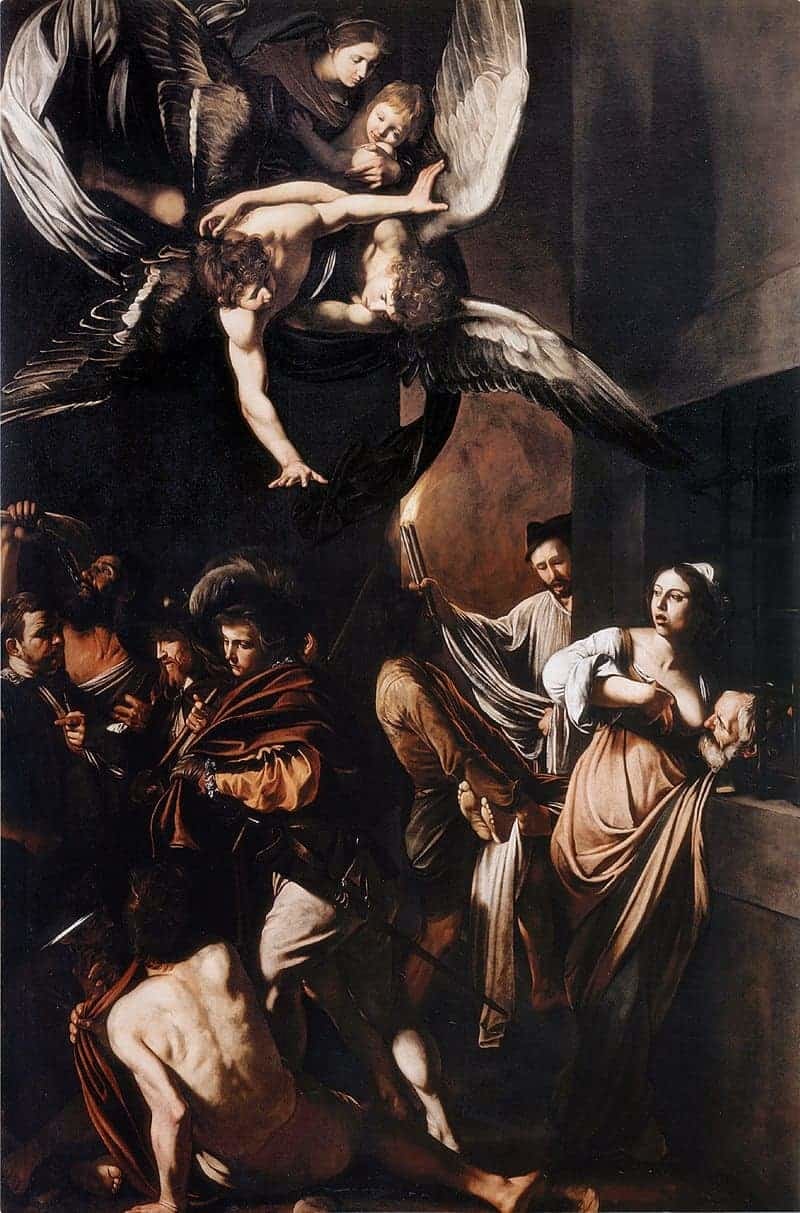
Caravaggio painted the monumental altarpiece in a very short space of time and by the start of 1607 it was probably already installed on the high altar of the church where it soon became one of the confraternity’s greatest treasures. (At a meeting of the congregation in 1613 it was decided that the painting should never be sold at any price!)
The success of this painting soon led to further commissions. His next painting, The Flagellation of Christ, also caused a sensation. Many were shocked by Caravaggio’s intense realism. The paintings were greeted with admiration but also bewilderment and he was responsible for a change in the way the Neapolitans saw art. His brutal sense of reality and his use of light caused a new school of painting to develop, first in Naples and later Spain.
Caravaggio in Malta
It is not known exactly why Caravaggio decided to leave Naples and head for Malta. His friends in Rome were still working behind the scenes to have him pardoned but so far without success. Perhaps Caravaggio hoped that by going to Malta he could gain himself a knighthood (which he did) and use that as a bargaining point in his quest for a pardon. For whatever reason, Caravaggio set sail for Malta in June 1607. (Checo, his long-time model and companion decided that it was time for a parting of the ways and remained in Naples.)
Malta was at that time an important military outpost held by the Order of the Knights of St John. The order had its origins in the Crusades and the Crusader kingdoms of the Middle East and had continued the struggle against the Islamic states long after the Holy Lands were lost. They were formally constituted as a nursing and military order and continued the fight against the Ottoman Empire from Malta after being expelled, first from the Holy Lands and then from Rhodes.
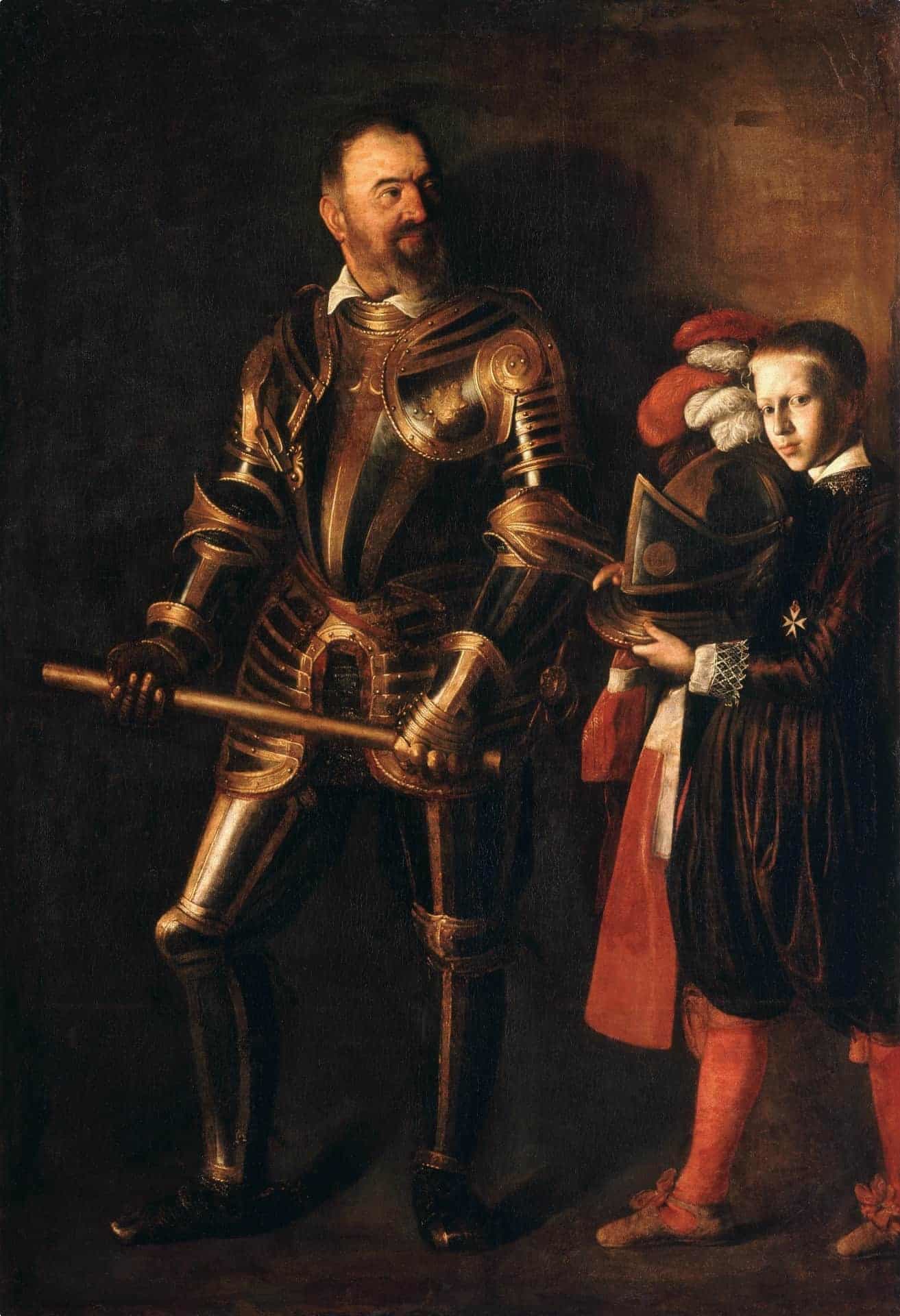
The Knights of St John were drawn from among the most aristocratic and militaristic families of Europe and were very proud of their position in society as well as their history of military prowess. They wanted to fight and, if necessary die a martyr’s death, in what they saw as a Holy War. In the circumstances Caravaggio had little to offer apart from his fame as a painter. It seems that this skill was enough to impress the Grand Master of the order and Caravaggio was given permission to land on the island.
The Grand Master, Alof de Wignacourt, wanted great works of art by the most acclaimed painter in Italy to beautify the churches of Malta and Caravaggio was that painter. Caravaggio may also have had help from some old friends. Costanza Colonna’s son, Fabrizio Sforza Colonna, had been exiled to Malta for “unmentionable crimes” but had managed to redeem himself and become something of a hero. It is quite possible that Costanza and her son helped Caravaggio to gain the support of the Grand Master.
Caravaggio managed to paint some of his most admired works on Malta before running into trouble once more. His The Beheading of Saint John the Baptist is considered by many to be the greatest painting of the seventeenth century. It is also the only known painting signed by Caravaggio, signed in the blood spurting from the saint’s neck! The painting was a great success and Caravaggio was given a gold chain and entry into the Order of St John.
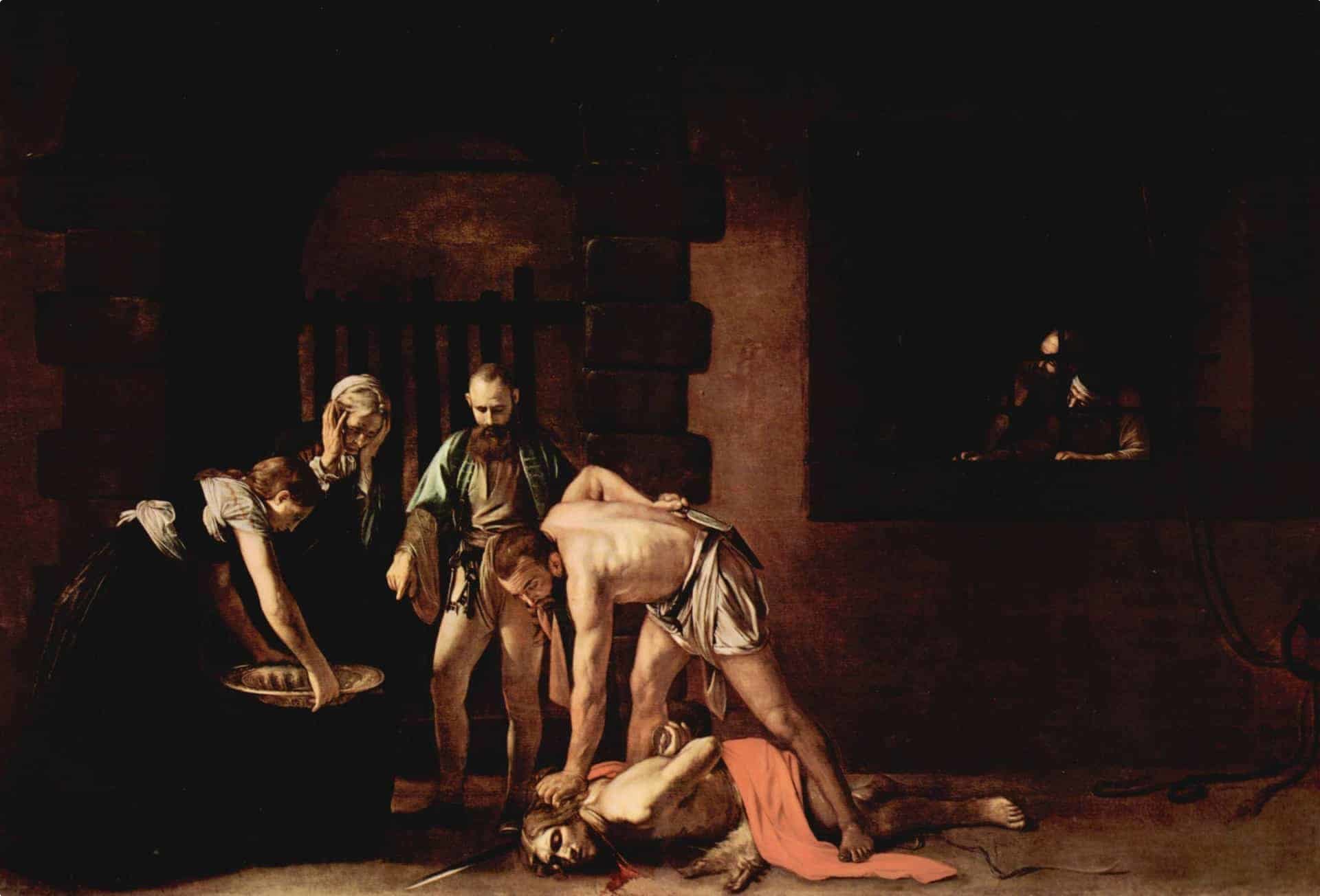
Once admitted into the Order of St John, Caravaggio had to promise to stay out of trouble but this, he could not do. Just weeks before his painting was due to be unveiled Caravaggio was arrested and thrown into prison. For 400 years it was not known exactly what happened. Rumours abounded, one of the most common being that he had been arrested for molesting one of the young pages, possibly the one shown in the painting with the Grand Master.
Recently, documents from the court case have finally been deciphered and they indicate that once more Caravaggio was caught up in a brawl. It seems that the brawl broke out in the house of an organist, Fra Prospero Coppini, and a high ranking knight was seriously wounded. Those involved, including Caravaggio, had broken their vows and punishment was inevitable.
The prison was meant to be invulnerable but somehow Caravaggio achieved what was thought to be impossible. He escaped from the prison and from the island. Once again he must have had help — and his old friends the Colonna family and their associates are the people most likely to have stepped up. Caravaggio was on his way to Sicily. He was tried in his absence and cast out of the order. Now, he was not only a declared felon in the Papal States, but he had upset the very powerful Knights of St John.
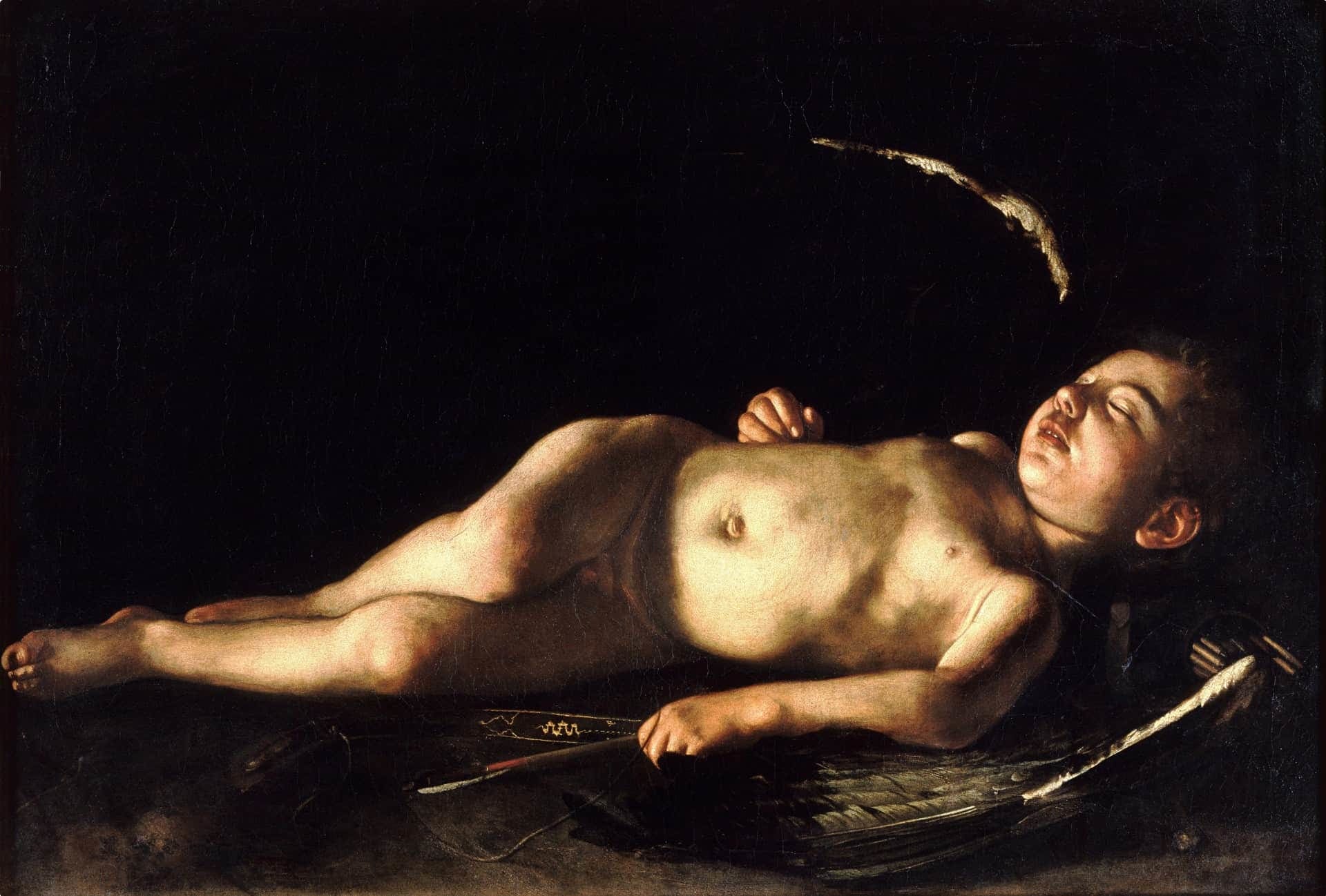
Sicily
Strangely enough the Knights seem to have made little attempt to recapture Caravaggio in Sicily. In Sicily he went to stay with an old friend, Mario Minniti. Minniti had modelled for Caravaggio’s Bacchus in Rome in 1596-7 but had returned to his home in Sicily where he had established a successful workshop in Syracuse. Now he was a well-respected member of the community and able to offer Caravaggio considerable assistance. He recommended Caravaggio to the Senate of Syracuse as the “best painter in Italy” and secured him a commission to paint The Burial of St Lucy. Caravaggio completed the commission but headed north to Messina before the work was unveiled.
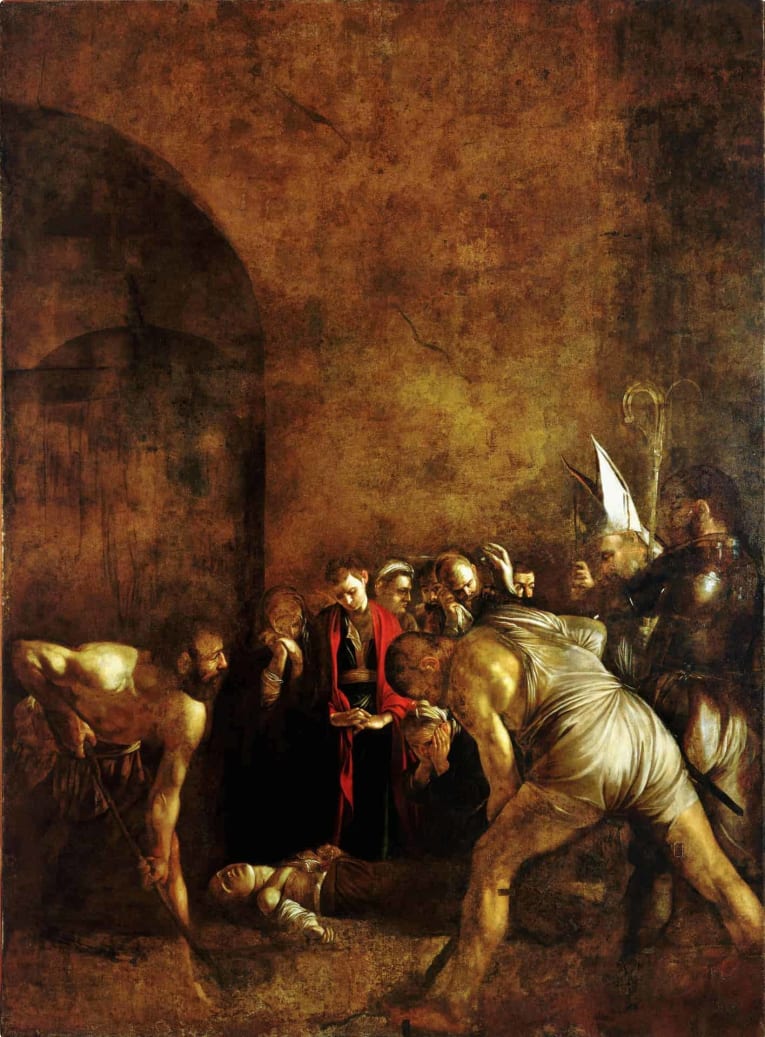
The Burial of St Lucy, 1608, Syracuse.
Caravaggio stayed working in Sicily until the autumn of 1609. During his time on the island he seems to have been troubled and afraid. He always kept a sword or dagger close at hand and bought himself a large guard dog named Crow. His work was in great demand and he was able to charge very high prices. None of this made him happy and his friends continued to work to gain him a pardon which would enable him to return to Rome.

Return to Naples
It appears once again to have been Costanza Colonna who arranged for Caravaggio to be able to leave Sicily and return to Naples. She was working with Scipione Borghese, the Pope’s nephew and a keen collector of Caravaggio’s work, to enable Caravaggio to obtain a pardon from the Pope in Rome. It seems that she had already obtained, at least, an unofficial pardon from de Wignacourt in Malta.
In the middle of September, Caravaggio went back to Naples and went to stay in the Colonna palace at Chiaia. Once he was back in Naples, he found himself again in great demand but he continued to worry about his safety. This worry was not unfounded and one night, after a visit to a tavern, Caravaggio was attacked and badly wounded by a group of armed men.
The identity of his attackers has not been established but one possibility is that the man responsible was the same one wounded in the fight in Malta. For him to take revenge could be seen as an act of honour. Caravaggio was cut on the face, a common form of ‘honour’ revenge. This appears to have been a premeditated act: three men to hold him down while a fourth marked his face.
Caravaggio was taken back to the Colonna palace while rumours of his death spread around Italy. His recovery was slow and the paintings he did over the next six months reflect the toll the attack had taken. The two paintings from this period, still known to exist, are very dark and the brush strokes (apparently) less assured. Buyers were, however, were still clamouring for his work.
The Return to Rome…
Caravaggio still hoped for a pardon from the Pope and to be able to return to Rome. He still had friends and patrons in Rome and he had good reason to believe that his quest for a pardon would be successful. Scipione Borghese, the Pope’s nephew, was a particularly keen collector of Caravaggio’s work.
On the 9th July, 1610, Caravaggio set out for Rome. He boarded a sailing boat previously used for transporting some of his paintings. Caravaggio must have felt that his troubles were over. Unfortunately, the boat made a routine stop at the port of Palo where Caravaggio once more found himself in trouble. He was arrested, for reasons unclear, and imprisoned. By the time he was released the boat had sailed away with three of his paintings – paintings he needed to secure his safety in Rome.
It is assumed that Caravaggio set out in pursuit of the boat and his paintings. His early biographers have him running madly along the beach. It is more likely that he hired a horse to carry him the 50 kilometres to the boat’s next port of call. Caravaggio made it to the next port, Porto Ercole, but he made it no further. Sick with fever he died in Porto Ercole and was buried in an unmarked grave.
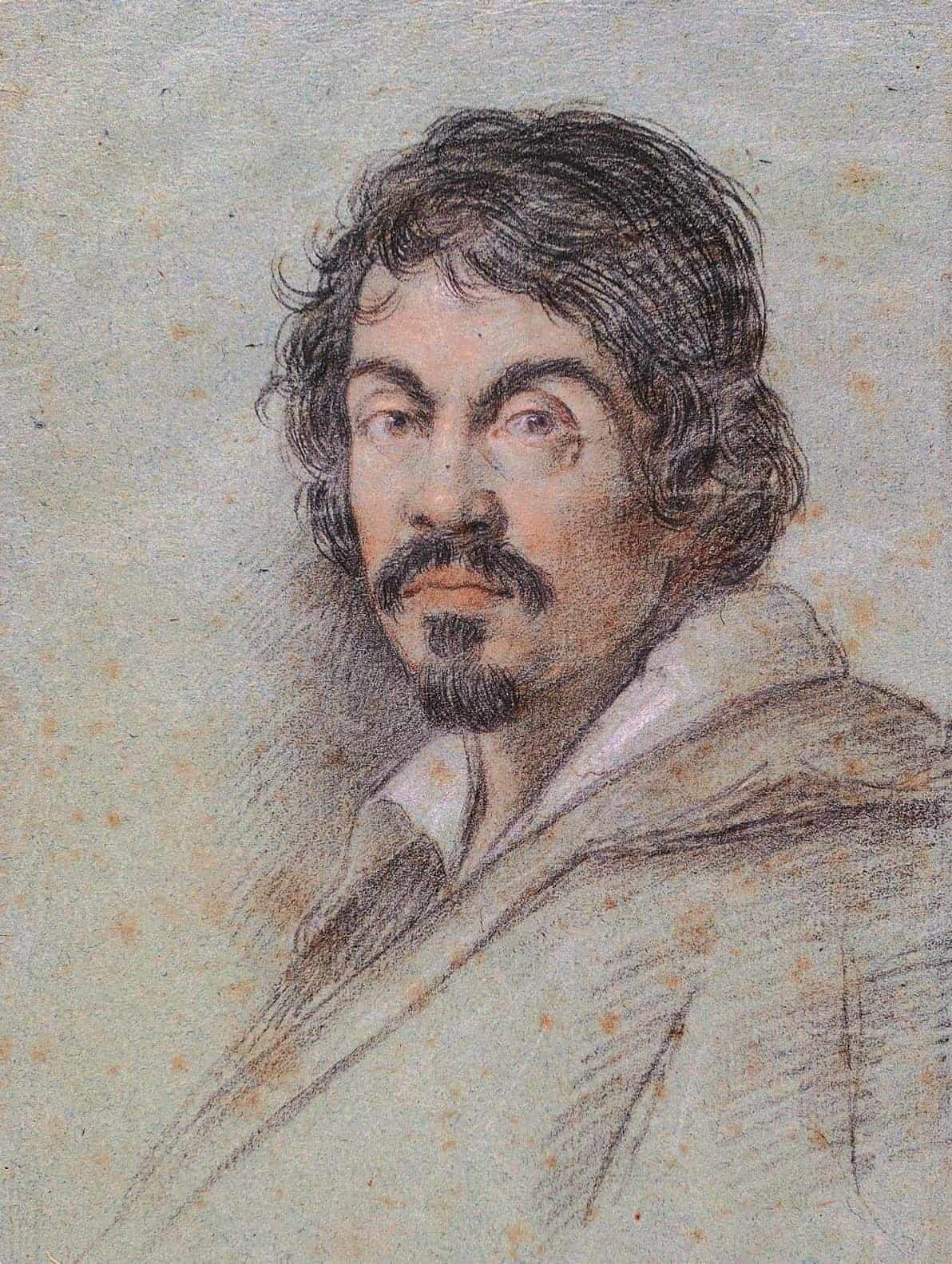
Odyssey Traveller’s small group tours
Odyssey Traveller is a not-for-profit organisation offering Australia and New Zealand’s most comprehensive educational tour programs. We provide worldwide experiences for mature travellers who are keen to blend a love of travel with a thirst for knowledge, and we welcome participants from any country.
Odyssey Traveller is famous for our small groups, and we average eight participants per tour. Our maximum group size is eighteen people, which ensures quality, flexibility and care that is tailored to our clients. We specialise in small group tours for the senior traveller who is seeking adventure or is curious about the world we live in. Typically, our clients begin travelling with us from their mid 50’s onward. But be prepared to meet fellow travellers in their 80s and beyond! Both couples and singles are welcome.
Related Tours
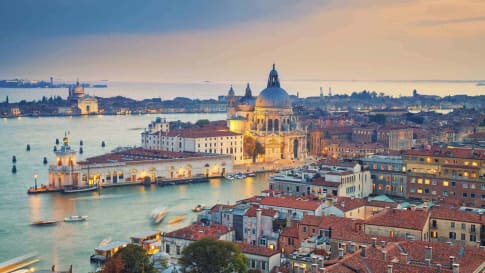
18 days
Aug, SepArt and History of Italy | Small Group Tour for seniors
Visiting Italy
Taken as a whole, Italian Civilization (which includes, of course, the splendid inheritance of Ancient Rome) is absolutely foundational to Western culture. Music, Painting, Sculpture, Architecture, Literature, Philosophy, Law and Politics all derive from Italy or were adapted and transformed through the medium of Italy.
From A$16,695 AUD
View Tour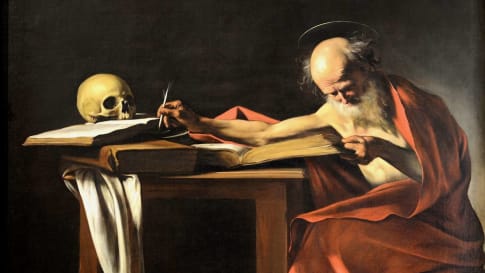
20 days
May, OctCaravaggio’s Journey | Small Group Tour in Italy
Visiting Italy, Malta
On this small group tour of Italy and Malta for mature and senior couples and solo travellers we trace the life of Caravaggio, exploring the artistic works he left behind and the tumultuous life he led. We follow him from his birthplace in Milan to Rome, Malta, Sicily and Naples. In each place he lived Caravaggio left behind a rich legacy of art for us to admire.
From A$15,125 AUD
View Tour
22 days
Mar, Sep, MayFlorence: Living in a Renaissance City
Visiting Italy
A small group tour with like minded people, couples or solo travellers, that is based in Florence. An authentic experience of living in this Renaissance city The daily itineraries draw on local guides to share their knowledge on this unique European tour. Trips to Vinci, Sienna and San Gimignano are included.
From A$14,375 AUD
View Tour